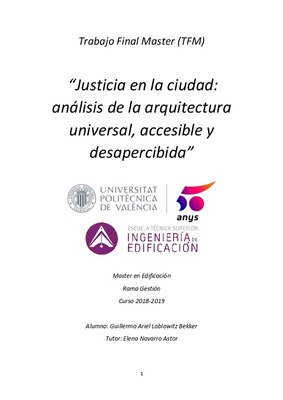|
Resumen:
|
[ES] La arquitectura y el urbanismo son disciplinas capaces de fomentar la interacción social de los habitantes de la ciudad. A través de su correcta planificación, la población puede utilizar y disfrutar de sus espacios ...[+]
[ES] La arquitectura y el urbanismo son disciplinas capaces de fomentar la interacción social de los habitantes de la ciudad. A través de su correcta planificación, la población puede utilizar y disfrutar de sus espacios tanto públicos como privados. Sin embargo, ¿qué sucedería si una inadecuada planificación urbana y diseño arquitectónico segregara a un sector minoritario de la sociedad, al generarle barreras arquitectónicas que le impidiesen realizarse con autonomía? Éste es el problema al que actualmente se enfrentan las personas con discapacidades físicas, sensoriales o intelectuales.
Este trabajo lleva a cabo un análisis de las dificultades y los retos que debe afrontar esta parte de la población en la actualidad. Se presentan estudios teóricos sobre la historia de las personas con discapacidad, conceptos y definiciones de interés, y técnicas para superar las barreras urbanas mediante una arquitectura accesible universal. Mediante el método de investigación cualitativo, se han realizado entrevistas personales a variados profesionales relacionados con la temática, que permiten visualizar la cuestión central del problema desde diferentes ángulos; ya sea desde sus motivaciones, su formación y su percepción sobre la ciudad de Valencia y sus normativas. Conscientes del problema social de la discapacidad, y en base a sus conocimientos técnicos, los participantes entrevistados intentan buscar soluciones innovadoras por medio de una arquitectura inclusiva.
Entre las conclusiones destaca la falta de capacitación de los profesionales, tanto en cuestiones técnicas como en la empatía hacia este sector de la sociedad. No se debe olvidar que este colectivo incluye no solo a las personas que nacieron con una discapacidad, sino también a aquéllos que la han ido adquiriendo en el correr de su vida.
[-]
[EN] Disciplines such architecture and urban planning are able to motivate a city inhabitants social interaction. Through proper planning, they can use and enjoy their public and private spaces, but ¿What would happen if ...[+]
[EN] Disciplines such architecture and urban planning are able to motivate a city inhabitants social interaction. Through proper planning, they can use and enjoy their public and private spaces, but ¿What would happen if an inadequate urban planning and architectural design segregate a part of the population, by generating architectural barriers that impede them to carry out autonomously? This is a problem that people with intellectual, sensory or physical disabilities are currently facing.
This work carries out an analysis of difficulties and challenges that this part of the population faces nowadays. Theoretical studies about the history, concepts and interest definitions of people with disabilities are presented, besides proposing techniques to overcome urban barriers through an accessible and universal architecture. Moreover, using a qualitative research method, personal interviews have been conducted with various professionals related to the subject, which allow to visualizing the main issue of the problem from different angles; either from their motivations, their education and their perception about Valencia city and its regulations. Being aware of the social problem disability is and based on their technical knowledge, the interviewed participants try to find innovative solutions through an inclusive architecture.
Conclusions include professional lack of training, both in technical and in empathy aspects towards this sector of society. We must not forget that this group includes not only people who were born with disabilities, but also those who have acquired them throughout life.
[-]
|







